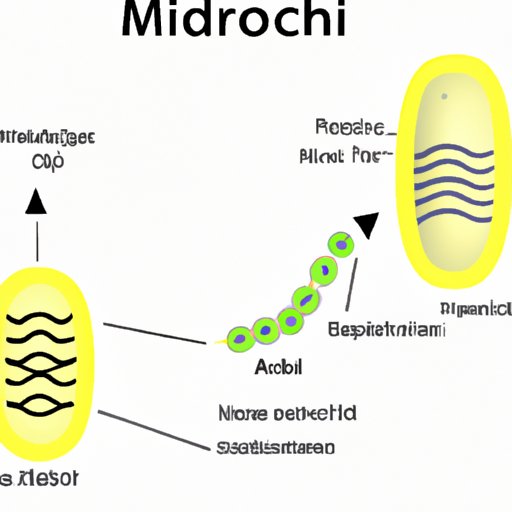I. Introduction
Imagine for a moment that your cells are like tiny houses, each with their own power source that keeps them running. Meet mitochondria, the powerhouse of the cell. Without mitochondria, our cells would not be able to function efficiently, and our bodies would suffer severe consequences. In this article, we are going to explore why mitochondria are so important, how they work, and their contributions to sustaining life and preventing disease.
II. Biology 101: A Comprehensive Look at Mitochondria as the Powerhouse of the Cell
Mitochondria are small organelles present in almost all eukaryotic cells. They are known as the powerhouse of the cell because of their ability to generate the energy required for cellular processes. Mitochondria are responsible for the production of adenosine triphosphate (ATP), which serves as the primary energy source for cells.
These organelles are composed of two membranes, the inner and outer membrane. The outermost membrane is smooth, while the inner membrane is folded, forming cristae. It is on these cristae where cellular respiration takes place, and ATP is produced.
III. Energy Factories: Understanding the Role of Mitochondria in Cellular Respiration
Cellular respiration is the process by which cells convert nutrients into ATP, which then fuels various metabolic processes. Mitochondria play a critical role in this process, particularly in the Krebs cycle and the electron transport chain. In this process, the cell uses oxygen to break down glucose via a series of steps into ATP, water, and carbon dioxide.
The role of oxygen in this process is important. Without oxygen, cells are not able to produce ATP efficiently, leading to various consequences such as muscle fatigue or brain damage.
IV. The Marvelous Mitochondria: Unlocking the Science Behind its Powerhouse Role
Mitochondria generate ATP via a complex process that involves various proteins and enzymes, leading to oxidative phosphorylation in the electron transport chain. Essentially, electrons are passed down a chain of proteins, releasing energy that is used to pump protons across the inner membrane into the intermembrane space. The protons are then allowed to flow back into the matrix through ATP synthase, generating ATP in the process.
Mitochondria also have their DNA known as mitochondrial DNA (mtDNA). This DNA codes for essential proteins that are part of the electron transport chain. Mutations in mtDNA can lead to mitochondrial dysfunction, compromising energy production and metabolism, leading to various diseases such as Leigh syndrome, Alzheimer’s, and Parkinson’s.
V. Power Up: The Importance of Mitochondria in Sustaining Life
Aside from ATP production, mitochondria play a critical role in various biological processes. These processes include apoptosis, aging, and metabolism. Mitochondrial dysfunction is associated with several diseases, such as cancer, diabetes, and neurodegenerative diseases.
In metabolic disorders, such as diabetes, insulin resistance can lead to mitochondrial dysfunction, and compromised ATP production leading to chronic fatigue. In neurodegenerative diseases such as Alzheimer’s and Parkinson’s, mitochondrial dysfunction leads to the accumulation of protein aggregates in the brain, leading to neuronal damage and cell death.
VI. How Mitochondria Became Known as the Powerhouse of the Cell: A Historical Perspective
The discovery of mitochondria dates back to the late nineteenth century. In 1880, Richard Altman first observed these organelles in liver cells and referred to them as bioblasts. In 1898, Carl Benda and Carl Correns independently observed mitochondrial inheritance, where the organelles were seen to be passed down from generation to generation.
It wasn’t until the 1960s that the groundwork was laid for understanding mitochondria’s key role in energy production. In 1961, the electron transport chain was discovered, shedding light on the process through which cells generate ATP. In 1962, Peter Mitchell proposed the chemiosmotic hypothesis that described the role of pH gradients in ATP synthesis.
VII. Breaking Down Mitochondria’s Capacity to Fuel Cellular Processes
Mitochondria’s role in ATP production and various diseases has motivated research aimed at understanding mitochondrial function and dysfunction. Researchers have developed methods to isolate mitochondria, perform experiments, and analyze the organelles’ molecular biology.
Research has led to a better understanding of how mtDNA mutations lead to mitochondrial dysfunction and the development of various diseases. Scientists are also developing innovative therapeutic strategies that target mitochondria to treat various diseases.
VIII. Conclusion
Mitochondria’s role as the powerhouse of the cell is critical and cannot be overstated. This small organelle plays a vital role in energy production, metabolism, aging, and disease development. Understanding mitochondria’s biology is critical to developing effective therapies for various diseases. As we continue to study mitochondria, we may unlock new therapeutic targets, and our understanding of cellular biology will continue to evolve.
